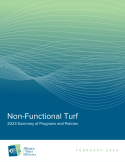Non-Functional Turf: 2023 Summary of Programs and Policies

AWE’s latest report, Non-Functional Turf: 2023 Summary of Programs and Policies, is a culmination of our work with water agencies from across the Colorado River Basin, who signed a joint memorandum of understanding in late 2022, committing to take additional actions to increase water efficiency to help protect and conserve water in the CRB region.
There is growing interest in saving water by limiting what has come to be known as “non-functional turf” (NFT). This is especially true in the Western United States, where climate change and persistent drought are straining water supplies. Turf is shorthand for turf grass of the type found covering lawns, landscaped areas around commercial spaces and roads, parks, ball fields, golf courses, etc. The Alliance for Water Efficiency has been tracking these developments and working alongside members and partners to increase information sharing and capacity building about NFT programs. This report captures some key trends and approaches to limiting NFT from 2023. These include:
- A range of definitions for what constitutes NFT;
- Different state and local approaches to reducing NFT;
- Efforts to map and quantify NFT and its water use;
- Water savings from transforming NFT into drought and climate-resilient landscaping;
- Plants to use instead of NFT; and
- Funding from federal, state, and local sources.
However, AWE recognizes that not every community will want to limit or replace traditional turf grass with less water-intensive landscapes depending on its climate, water supplies, and other factors. There are a range of promising approaches to limiting outdoor watering, including landscape irrigation efficiency improvements, water budgets, low water use turf varieties, education, and more. These approaches are outside the scope of this report, and you can find more info on landscapes in general here.





